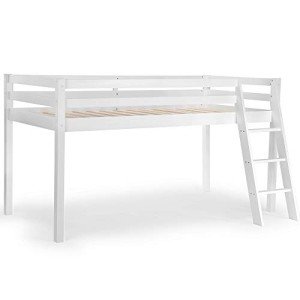The Most Common Bunk Beds Sale Mistake Every Beginner Makes
Bunk Beds Sale: A Comprehensive Guide to Choosing the Right Bunk Bed for Your Home
Bunk beds have long been a staple in kids's bedrooms, offering a mix of space-saving performance and enjoyable. Whether accommodating siblings, friends on pajama parties, or merely taking full advantage of a playroom, bunk beds have ended up being a vital element in modern household homes. As Bunk Bed For Kids on bunk beds rise, it ends up being increasingly essential for customers to make educated choices when acquiring one. This short article will cover the fundamentals of purchasing a bunk bed, from types to security features, in addition to suggestions for preserving the integrity of your investment.
Kinds Of Bunk Beds
When thinking about a bunk bed sale, it's important to understand the different designs offered on the marketplace. Below are the most typical types:
Traditional Bunk Beds: These consist of two beds stacked one above the other, sharing a single frame. They are often the most cost-effective choice.
L-Shaped Bunk Beds: This style includes one bed positioned vertically and another horizontally. This plan creates additional space below the upper bed, which can be utilized for storage or a play area.
Lofted Beds: Similar to conventional bunk beds but with no lower bed. Instead, the space below can be used for a desk, play area, or extra storage.
Triple Bunk Beds: For families with a bigger number of kids or frequent pajama parties, triple bunk beds offer 3 sleeping locations in a space-efficient style.
Futon Bunk Beds: These designs merge bunk beds and futon couches. The bottom area transforms into a separate seating area, improving functionality.
Convertible Bunk Beds: These beds can be separated into two specific beds, making them versatile as kids's requirements alter with time.
Table 1: Comparison of Bunk Bed Types
Type
Description
Space Efficiency
Extra Features
Traditional Bunk Bed
2 beds stacked vertically
High
Easiest style
L-Shaped Bunk Bed
One vertical and one horizontal bed
Moderate
Play or storage space
Lofted Bed
Raised bed with open space listed below
High
Work/play location
Triple Bunk Bed
Three stacked beds
Extremely High
Accommodates more users
Futon Bunk Bed
Bunk bed with a convertible futon
High
Multi-functional
Convertible Bunk Bed
Can be divided into two different beds
Moderate
Versatility & & durability
Safety Features to Consider
Safety is critical when investing in a bunk bed. Below are key security features to try to find:
Guardrails: Adequate guardrails need to exist on both sides of the upper bunk to avoid falls. They ought to be at least 5 inches higher than the mattress.
Ladder Design: Look for strong, large ladders with slip-resistant rungs. Guarantee that the angle is not too high for easy gain access to.
Stability: Ensure the bed is constructed with strong materials, such as strong wood or sturdy metal. The bed must not wobble when in usage.
Weight Limit: Check the weight capability of the bunk bed to guarantee it can accommodate the intended users securely.
Product Safety: If possible, choose beds made from non-toxic products or those meeting safety requirements for children's furnishings.
Table 2: Essential Safety Features
Feature
Description
Importance
Guardrails
Sides of upper bed to prevent falls
Essential for kid safety
Ladder Design
Strong, slip-resistant rungs
Help safe and easy gain access to
Stability
Develop quality to prevent wobbling
Makes sure security and longevity
Weight Limit
Maximum weight capacity
Prevents mishaps
Material Safety
Non-toxic, safe materials
Secures children's health
Maintenance Tips for Bunk Beds
To extend the life of your bunk bed and guarantee continuous safety, think about the following upkeep tips:
Regular Inspections: Periodically inspect the structure for loose screws, bolts, or any signs of wear. Tighten fasteners as required.
Clean Periodically: Dust and clean the surface areas routinely. Use appropriate cleaners that won't harm the surface.
Examine Weight Limits: Be mindful of weight limitations, particularly with older kids or adults who might wish to use the upper bunk.
Avoid Climbing on Guardrails: Educate children not to utilize guardrails for climbing up or playing to reduce the danger of mishaps.
Often Asked Questions (FAQs)
Q1: What is the age limit for children to securely utilize bunk beds?A: While it differs by the maker, lots of advise that children under six should not sleep in the upper bunk due to security issues.
Q2: How can parents prevent risky climbing?A: Setting clear rules about bunk bed use and supervising kids can assist. Additionally, utilizing a bed tent can discourage climbing while creating a fun sleep environment.
Q3: What should I consider when decorating a room with bunk beds?A: Ensure there suffices space around the bunk bed for safe motion, and use the decoration to create personalized areas for each child.
Q4: Is a lofted bed suitable for older kids?A: Yes, lofted beds can be ideal for older children as long as they fulfill safety requirements and the kid is responsible enough to use them safely.
Bunk beds serve a functional function while adding a component of fun to a kid's bed room. As sales of bunk beds continue to increase, cautious consideration of types, safety functions, and upkeep practices is necessary for moms and dads and caregivers. By understanding these essential factors, families can discover the perfect bunk bed for their home, guaranteeing both practicality and security for several years to come. Whether it's for brother or sisters sharing a room or creating a cozy slumber party space, a well-chosen bunk bed can provide happiness and functionality, making it a deserving financial investment.
